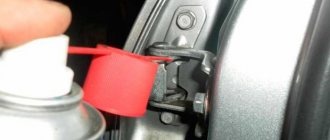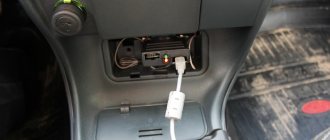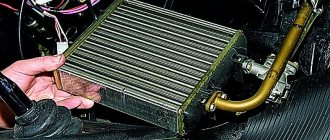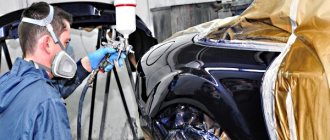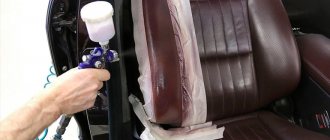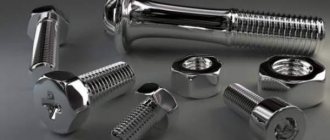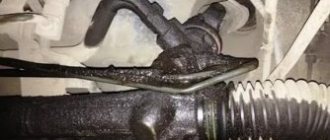- home
- Tuning
- …
This is probably a problem with all leather steering wheels; sooner or later they begin to peel off. Not the physical skin, but the paint on its surface. And you start to have telltale bald spots that are really annoying! DAMN, why take a “leather steering wheel” if in a year or two it will peel off like a “torn cat.” I would take plastic and drive for an endlessly long time! OKAY - sadness, there is a car, there is a “hearth”, something needs to be done. Is it possible to somehow paint or restore this place? Let's find out...
To be honest, guys, I also had such a problem on my steering wheel, it was simply wear and tear on the rear edge of the leather surface. It looks annoying, especially if you are selling a car - it is very noticeable. What remains needs to be painted or restored. Although for myself personally, I see three solutions to the problem. That’s exactly what we’ll talk about today...
Guarantee or “don’t be stupid”
The first solution to the problem is simply a guarantee. Nowadays it’s the way it is (and for many brands) - that the steering wheel wears out (the first signs appear) after a mileage of 40 - 60,000 km, and for a large metropolis such as Moscow or St. Petersburg, this is mere “pennies”. Even if you are not a taxi driver or an employee of a delivery business (flowers, pizza, sushi, etc.), it’s easy to cover such mileage. So what to do! While there is a guarantee, we go to the official dealer.
Wear of the steering wheel skin is the same malfunction as, say, the failure of a stabilizer link or the failure of some rubber bands. And this “position” must be changed under warranty.
Guys, don’t be stupid, go to the dealer and point out the problem, he is obligated to fix it for you! How he will do this is a second question, but the surface must be restored.
Typically, the warranty period for a car is from 2 to 5 years. I would like to immediately note that on German cars, the leather will last the entire warranty period, often 2 years; then you can only restore it yourself.
On other brands where the warranty is from 3 to 5 years, you need to be careful. If it’s 3 years old, then the steering wheel may already be worn out, the IMPORTANT thing is to have time to show it to the dealer before the end of the term. If it’s 5 years, you need to be careful, for example, on cars like KIA and Hyundai, the warranty on all components is only three years or 70,000 kilometers, and after that only on the engine, electronics and gearbox. So you need to be careful, after this period it is useless to download your license.
What else I would like to note is that the dealer can turn on “Vanka”, like “I’m not me, this doesn’t change under warranty, etc.!” Guys, we immediately look for a car lawyer and litigate quickly and efficiently, without wasting time. As a rule, after a prepared claim to the address of the salon, in triplicate, everything falls into place - FOR I AGAIN EMPHASIZE - THIS IS THE SAME MALFUNCTION AS HUNDREDS OF OTHERS, AND IT MUST BE FIXED. BUT only during the warranty period! Remember this!
Okay, I think I’ve given you the essence of the direction, so use it, but what to do if the warranty has expired? How to restore paint yourself and is it possible?
Of course, perhaps for myself I see two ways, I propose to consider each separately.
Why do you need to care for your steering wheel?
At first glance, this seems like a trifle, but, nevertheless, your mood while driving, and, therefore, your safety, can depend on the cleanliness of the steering wheel.
In addition, from various types of contamination on the surface of the steering wheel, for example, from dust, some drivers may experience an allergy attack, which can lead to big troubles on the road.
The conclusion suggests itself - the steering wheel requires careful care.
New case
What can I say, this is the simplest, but also the most “collective farm” method of surface restoration. Now I don’t want to offend anyone, some drivers can make a really beautiful braid , which is often bought in Chinese stores. It is simply stretched and sheathed with special threads; in fact, the entire restoration ends there. That is, the abrasion is located under this braid. This is the cheapest way, I have friends who ordered leather cases for only 200 - 500 rubles.
It’s more difficult when all the steering wheel skin is removed, that is, the seams are physically cut and the standard braid is removed. Then a new one, made of fresh leather, is installed in its place. Not everyone can do this, and often there is simply no reason to! After all, you need very strong damage to the surface (a cut or deep abrasion), then it makes sense. Yes, and special companies are engaged in such restoration; you are unlikely to do it yourself; it will be “a bit complicated.”
However, this method of restoration is worth noting; after all, usually a new cheap case saves the situation.
There is another method, more correct, you need to follow this path.
Adjusting the driver's seat
The first thing that needs to be taken into account when adjusting the seat is the individual characteristics of the driver: his height, build, how much he weighs. We will tell you in more detail at the end of the article, but for now about the main recommendations.
How to adjust the driver's seat:
- the seat back is tilted at an angle of 75-90 degrees - the numbers may vary depending on how many hours a person spends behind the wheel
- The headrest is adjusted parallel to the back of the head.
The driver sits in his seat so that there are no gaps between his back and the back of the chair, at least 3 cm of power reserve remains to the edge of the seat, and his feet rest calmly (without tension) on the pedals.
What errors might there be?
First: Excessive recline of the chair back.
If we take racing cars as an example, where the pilots practically lie in their seats due to the fact that the seat backs are located vertically. This design allows not only better control of the steering wheel, but also less fatigue. There is no scientific explanation for why this happens, but motorsport professionals have proven everything in practice.
When sitting as a pilot, it is important that the shoulder blades fit well into the seat and do not come off, even if the range of motion of the shoulders is maximum. To ensure full contact between the back and the chair, it is designed with special curves
Drawing a parallel with the car and a regular vehicle, we can conclude:
If the back of the seat is excessively tilted, the driver will simply hang on the steering wheel during the maneuver (severing the shoulder blades). It turns out that he will no longer be able to control the car.
Adjusting the driver's seat
Second: the headrest is very low.
The headrest, as an element of the seat, performs the function of protection, and then comfort. When setting up, do not forget about this fact. For example, the headrest in Volvo models is not adjustable. And these cars are considered one of the safest for a reason.
What happens if the headrest is not adjusted correctly? At the moment of a collision, a sharp “whiplash” movement of the head will occur, which can cause severe damage to the cervical vertebrae.
If the back of the head was protected by a head restraint during the impact, then the protection function of this element will work as expected.
It is also worth mentioning about cars with seats that provide horizontal adjustment of the headrest. The parameters will be as follows: the headrest should be located no further than three to four centimeters from the back of the head.
Painting and priming the leather on the steering wheel
If you do not have any damage that is deeply embedded in the surface, you can paint and prime it yourself. This is the most effective method for abrasions from 3 to 5 years. I have several friends who did everything with their own hands and it turned out impressive!
What we need, firstly, a special set, it includes:
- Degreaser
- Paint, usually water-based
- Finish matte coating
- Sometimes the morning is a strong degreaser
- Also an ultra-strong cleanser
- Putty paste (in advanced cases)
- “Stitcher”, a property that tightly binds the putty and the top layer of paint
Personally, I have seen all this in many kits in stores to restore the surface of the steering wheel leather. But often you just need a "degreaser", paint and a matte finish.
That's all. Let's look at the restoration process itself - painting.
Recovery process
What I would like to note before the process is that you definitely need to buy masking tape and a large cellophane to close the interior, otherwise the paint will settle in the interior, which is not what we need.
- We cover those parts that do not need restoration, usually these are wooden inserts or central plastic elements. We “wrap” the front panel and the seats in cellophane.
- We clean the damaged surfaces with fine sandpaper. Not much, usually until white skin appears.
- We degrease the steering wheel and apply a special compound that should remove all greasy elements. If it is not enough, you need to use stronger formulations (morning remedy). After this, we wipe the steering wheel so that there is no dirt or any other grease left.
- Then, if there are deep damages, they can be repaired with a special primer.
- After this, we apply a layer of paint, simply spray it from a spray can. Apply with “short” movements; you don’t need to stop for a long time at one point, because it will flow.
- After it dries, about 30 - 40 minutes, you need to cover it with a matte finish. This is what will fix the paint layer.
- If you used a primer, then you need to apply a layer of “crosslinker” before painting. It will fix the primer and prevent it from falling apart.
As you can see, painting and restoring the leather on the steering wheel is nothing complicated, it literally takes a couple of hours. One more warning, it is advisable to carry out all work in a closed box so that dust does not fall on the surface to be painted.
Now let's watch a short video.
This concludes the article, read our AUTOBLOG.
Similar news
- EVA mats. My honest review! Which ones are better to choose for the car?
- Do-it-yourself caterpillars for a car or a tank from Niva and UAZ. What is the price...
- AUDI A1 Quattro
Add a comment Cancel reply
Selection of restoration products
If there are only isolated abrasions, radical repair is not required. To maintain and restore your appearance, it is enough to purchase one of the above products:
- skin care products labeled "restorative". The drug works in much the same way as shoe polish. Their advantages are that they do not run off at high temperatures, do not stain hands, are easy to apply and do not require large expenses;
- Protective agents in the form of impregnations and special creams. They perform a broader function: special impregnations remove already formed greasy stains and also prevent the formation of new ones.
If the steering wheel has extensive scuffs, cracks, or scratches, it is worth carrying out a full procedure for removing stains and renewing the leather braid. To do this, you need to purchase a special paint for leather.
When choosing paint, pay attention to the characteristics of the upholstery material.
If the leather steering wheel is vegetable tanned, it is preferable to use soft paints, as they are highly absorbent. Soft paints are sold in abundance because this material is considered the most popular. However, if the steering wheel is made of chrome-tanned leather, the paint composition should be more rigid, since it absorbs less moisture. This should be checked with your dealer.
If the skin color is black, a standard color is sufficient. If the steering wheel is a different color (beige, red), then several base paints will be required to tint it and obtain the desired shade.
For drivers of non-standard build
To begin with, it is worth explaining what is considered a non-standard configuration. This is when the driver is shorter/higher than 165-175 cm in height, more than 90 kg, or other characteristics (we will consider below). To make driving more comfortable and safe, it is worth taking additional measures:
- For those with weak hands, you can change the steering wheel to a larger size than usual. At the same time, the grip of the steering wheel is wide with both hands, at the top of the rim.
- For those with long arms: the back of the chair should be tilted more than 75-90 degrees. The buttocks should be on the edge of the chair. There is only one inconvenience - your neck will get tired quickly.
- For those with short arms: legs should be bent, body in an upright position. You can also bend the gearshift knob so as not to lean towards it.
- If you have long legs, you need to take a pose where your legs and body form almost a right angle.
Sequencing
1. Thoroughly clean the steering wheel from grease and dirt and leave to dry naturally.
2. Cover all buttons and the airbag with masking tape. It is best to use a high-quality and thin product, since cheap masking tape will not adhere well to the surface and the coloring matter may leak under it.
3. Take a small rag and apply a mild solvent. Carefully treat the entire steering perimeter and damaged areas. Don’t be afraid to erase the excess, we will hide all the bald spots at the end.
4. The steering wheel can be removed or left in the car - as you wish. In the second case, in order not to stain the interior, cover the dashboard, seats and dashboard with rags or newspapers.
5. Now you need to prime the steering wheel. Apply the material in 3 layers, alternately allowing each to dry. To speed up the process, some craftsmen dry the primer with a hairdryer. However, we do not recommend this as you risk deforming the soft plastic parts of the steering wheel.
6. When the primer has dried, begin sanding the surface. Gently go over the entire steering wheel with fine-grit sandpaper. Be careful not to disturb the layers. After smoothing out the imperfections, wipe the steering wheel with a soft and clean cloth, which will remove abrasive particles.
7. The final stage is painting the perfectly smooth steering wheel with liquid leather. We recommend squeezing a small amount of paint into a separate container and applying the liquid with a small roller, like a swab. This tool will help create a texture reminiscent of leather. Apply one coat of paint and let the steering wheel dry. It is best to carry out restoration away from direct sunlight and dust. If necessary, you can apply another layer of liquid leather.
The result of the restoration will exceed all expectations. Your steering wheel will look like new and will last for quite a long time. However, rubbing of the surface is not the only problem that can arise with the steering wheel. Quite often, drivers complain about steering wheel vibration when braking. Read how to solve the problem without purchasing a new drive.
Did you like the article? Then support us, click
:
Source
Aftercare
Someone might think that taking care of the steering wheel is far from the most important thing in car care. But in addition to the untidy appearance of the interior, other problems arise: drivers with allergies can react sharply to excess dust that accumulates in the microfolds of the leather covering.
In order for the surface of the steering wheel to remain clean and intact for a long time, it must be properly cared for. It is not enough to wipe your hands with wet wipes before handling the steering wheel: in any case, small grease stains will remain on the coating, which will become more noticeable over time. To thoroughly clean the surface, regularly use special products for car leather care. If desired, this product can be replaced with a regular solution of water and car shampoo. To remove dirt, apply a small amount of product to its surface, wait 10-15 minutes, and then wipe thoroughly with a soft cloth. This process will take you no more than 20 minutes.
regularly clean the surface of the steering wheel from dirt
If you wear rings, they may leave scratches on the leather surface. There are two options: either remove the metal decorations, or repeat the steering wheel restoration process as necessary.
Even if you purchase the most expensive and high-quality products for restoring the steering wheel coating, the amount spent will be several times less than when going to a car repair shop. Restoring and painting the steering wheel is far from the most difficult process in car care. To get the job done quickly and efficiently, follow our instructions exactly.
Preparatory stage of independent work
It is recommended to dismantle the part before starting any work. This way you will be sure that you will not paint over anything unnecessary inside the interior. If for some reason dismantling is not possible, carefully cover all adjacent areas, including the control panel, as well as the spokes and buttons on the steering wheel using masking tape and film.
If you do not want to remove the steering wheel, carefully protect all areas of the interior that may get paint.
But it will be much safer and more convenient to remove the steering wheel and take it out of the car.
Removing a car steering wheel
To remove the steering wheel with your own hands, you only need a set of screwdrivers. Be careful: if this is your first time, there is a risk of damaging some of the mechanisms inside the steering wheel. The removal process may vary depending on the make and model of the vehicle. We will offer the most universal method that is suitable for most foreign cars.
Restoring and updating a car dashboard with your own hands using painting
First, disconnect the battery terminals. No current should be supplied to the steering wheel during dismantling. Turn the steering wheel at an angle of 90°. It should be in a straight position. Take out the airbag
To do this, insert a screwdriver one by one into the holes located in the rear of the steering wheel and bend the springs holding the cushion inside. Carefully pull the center part of the steering wheel towards you along with the cushion. You will see that special clamps do not allow it to come out completely.
They are easy to bend using a flat blade tool. After you disconnect the connectors with wires, move this element to the side. Disconnect the connector next to the center bolt. Remove the central bolt that holds the steering wheel in place. Gently pull the steering wheel towards you, applying force.
Congratulations! You've already done half the job: dismantling the steering wheel. Now you can begin restoring its coating.
Video: how to remove the steering wheel with your own hands
Restoration of the steering wheel surface: leather cleaning technique
Before painting the steering wheel, you need to restore the leather material itself. The duration of this process directly depends on the condition of the coating: if there are a lot of holes and scratches on it, you will have to tinker hard to return the steering wheel to its original appearance.
- Arm yourself with P600 or P400 sandpaper and carefully sand the damaged areas. If there are a lot of them, then remove all the paintwork in this way.
- Take a finer-grained abrasive and sand the entire surface of the steering wheel with it. You want to achieve a matte finish. Gray Scotch-Brite works well for these purposes.
- If you see a large number of oil stains on the steering wheel, apply a special absorbent to it and then wipe it.
- Now you need to restore the leather covering. To do this, use liquid leather. Apply the product to the damaged areas, dry, and then polish with a fine abrasive until smooth.
- In addition to liquid leather, there are other products designed to eliminate unevenness, for example, putty paste. The principle of its use is the same: level the coating, and then clean off the residue with sanding paper.
- If wrinkles have formed on the skin, smooth them out using a special conditioner and polish.
- Degrease the part using a soft cloth soaked in a special product.
Many motorists make the same mistake: applying too much degreaser. Because of this, the skin becomes wrinkled and begins to crack even more. After degreasing the surface, do not wait too long: you need to start painting work almost immediately, otherwise the coating will become greasy again and the paint will not adhere well.
Preparatory stage
So, we need to cover the dashboard with plastic film so as not to stain the interior of the car with paint and other materials. It is best to attach the film with masking tape. Painting tape will also help protect the spokes and buttons on the steering wheel from paint. If you nevertheless decide to dismantle the steering wheel in order to paint it outside the car, then you should understand that there is a risk of damaging the steering mechanisms if you have not previously performed this procedure. Yes, it is more convenient to paint with the steering wheel removed, but most motorists make do with protective film in the interior. Well, those who will remove the steering wheel with their own hands need to know the procedure:
- The steering wheel must be completely de-energized by disconnecting the battery terminals;
- Turn the steering wheel so that it is in the “straight” position;
- Remove the bolts securing the side plugs using a socket wrench;
- Remove the plugs;
- The steering wheel lining bolts also need to be loosened;
- Now, as carefully as possible, pull the trim up and disconnect the connectors with the airbag wires. The pillow capsule must not be touched.
- For convenience, place marks on the main shaft and on the steering wheel itself, and then unscrew the nut and remove the steering wheel.
The next part of the preparation is the removal of all cracks, scratches, dents and other defects that have formed on the steering wheel over a long (or short) period of service. Why is it worth starting with skin restoration? The fact is that painting may not be necessary if the coating is not too old and worn out. Once all the defects are removed, you will evaluate and decide whether a major upgrade is worth it.
To reveal all damage, you need to thoroughly sand the skin.
This is best done using sandpaper with a grit of P400 - P600. This procedure will also remove old paint and improve the adhesion of the new layer of paint to the skin. After you remove the paintwork from the leather, you can pick up a softer polishing material: either gray Scotch-Brite or P1000 - P1200 sandpaper is used for these purposes.
Now the skin on the steering wheel needs to be thoroughly degreased so that the painting is smooth and of high quality. It will be good if you purchase a special leather cleaner, but if finances are limited or intended for other things, then you can use our favorite “white spirit”
Important: leather very easily absorbs such degreasers after sanding, so you should lightly wet the rag. This is one of the most common mistakes: drivers try to thoroughly wipe the leather with a degreaser, not sparing white spirit. The result is dry and wrinkled skin.
What to do with wooden overlays
Luxury cars can have steering wheels decorated with elements made of natural wood. They wear out infrequently because they are protected with very high-quality varnish. But if the driver wears rings on his fingers, the varnish may get scratched.
You can try to polish a small scratch on varnished wood. To do this, it is first sanded with sandpaper, and then, gradually reducing the grain and polishing with paste, the surface is brought to perfection. If the scratch is too deep and in a visible place, then the steering wheel will require a thorough restoration.
Deep scratches on the varnish must be sanded completely. On the steering wheel, this work can be done manually, but it is easier and faster to grind with a portable drill with a nozzle of a suitable diameter. For a good result, it is better to matte the entire element - then the new varnish will lie perfectly.
To varnish a wooden steering wheel, it is recommended to use high-quality polyurethane varnish. This is the most durable, wear-resistant material with sufficient elasticity. Cheap varnishes wear out quickly and can also crack, peel, and so on.
